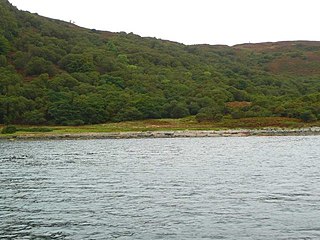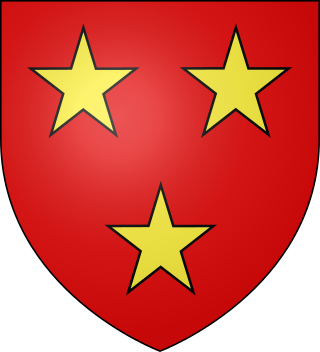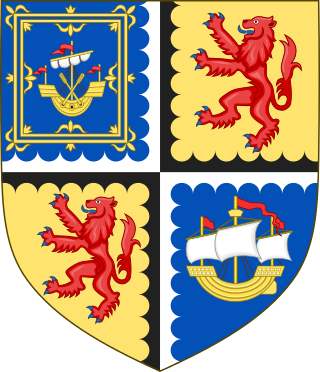Related Research Articles

Earl of Sutherland is a title in the Peerage of Scotland. It was created circa 1230 for William de Moravia and is the premier earldom in the Peerage of Scotland. The earl or countess of Sutherland is also the chief of Clan Sutherland.

Clan Mackay is an ancient and once-powerful Highland Scottish clan from the far North of the Scottish Highlands, but with roots in the old Kingdom of Moray.

Clan Sutherland also known as House of Sutherland is a Highland Scottish clan whose traditional territory is the shire of Sutherland in the far north of Scotland. The chief of the clan was also the powerful Earl of Sutherland, however in the early 16th century this title passed through marriage to a younger son of the chief of Clan Gordon. The current chief is Alistair Sutherland who holds the title Earl of Sutherland.
The Battle of Torran Dubh also known as the Battle of Torran-dow or the Battle of Torran Du was a Scottish clan battle that was fought in 1517 in Sutherland, in the Scottish Highlands.

The Battle of Alltan-Beath, also known as the Battle of Ailtan-Beath, was a Scottish clan battle said to have taken place in 1542 in the village of Knockarthur, in Sutherland, in the Scottish Highlands. It was fought between men of the Clan Mackay and men of the Clan Sutherland whose chiefs were the Gordon, Earls of Sutherland.

The Battle of Allt Camhna was a Scottish clan battle fought in 1586 between the Clan Gunn and Clan Mackay against the Clan Sinclair.

The Mackays of Aberach also known as the Clan Aberach are a Scottish family and a branch of the ancient Clan Mackay of the Scottish Highlands. They were the senior cadet branch of the Clan Mackay and were seated at Achness, in Strathnaver, which is in modern-day Sutherland. In Scottish Gaelic they are known as the Sleaght-ean Aberigh.
Angus Du Mackay, 7th of Strathnaver was the seventh chief of the Clan Mackay, a Highland Scottish clan. He is recorded in the 15th-century Scottish chronicle, Scotichronicon, as Enneas-en-Imprissi meaning Angus the Absolute due to his power of commanding 4000 men.

Robert Sutherland, was the 6th Earl of Sutherland and chief of the Clan Sutherland, a Scottish clan of the Scottish Highlands.

The Battle of Alltachuilain (or Ald-Quhillin was a Scottish clan battle that took place in 1518 or 1519 in the parish of Loth, county of Sutherland, Scotland. It was fought between factions of the Clan Sutherland in a dispute over the Earldom of Sutherland.

The Battle of Clynetradwell was a Scottish clan battle that took place in 1590 in the county of Sutherland between the forces of Alexander Gordon, 12th Earl of Sutherland and George Sinclair, 5th Earl of Caithness.
The Murrays of Aberscross were a minor noble Scottish family who were seated at Aberscross Castle, in the county of Sutherland, Scotland. The Murrays in Sutherland are recorded specifically as a clan in two acts of the Scottish Parliament of the 16th century.
Iye Du Mackay, 12th of Strathnaver, was the chief of the Clan Mackay, a Highland Scottish clan, from 1550 to 1572.
The Sutherlands of Kilphedder (Killipheder) were a minor noble Scottish family and a branch of the ancient Clan Sutherland, a Highland Scottish clan. They were seated at Killipheder, in the county of Sutherland, Scotland.
Iye Roy Mackay, 10th of Strathnaver, was the tenth chief of the ancient Clan Mackay, a Scottish clan of the Scottish Highlands.
John Mackay, 11th of Strathnaver, was the eleventh chief of the ancient Clan Mackay, a Scottish clan of the Scottish Highlands.
Donald Mackay, 11th of Strathnaver, was the eleventh chief of the ancient Clan Mackay, a Scottish clan of the Scottish Highlands.

George Sinclair was a Scottish nobleman, the 5th Earl of Caithness and chief of the Clan Sinclair, a Scottish clan based in northern Scotland.

Elizabeth Sutherland, was the 10th Countess of Sutherland having succeeded to the Earldom of Sutherland after her brother John Sutherland, 9th Earl of Sutherland died in 1514.
Alexander Gordon, 12th Earl of Sutherland was a Scottish landowner.
References
- Robert Gordon of Gordonstoun, A Genealogical History of the Earldom of Sutherland, from Its Origin to the Year 1630; with a Continuation to the Year 1651, Edinburgh (1813)
- 1 2 3 4 5 6 7 8 Mackay, Angus (1906). The Book of Mackay. pp. 77–85.
- ↑ Mackay, Angus. (1906). The Book of Mackay. p. 82. Quoting: Fraser, Sir William, The Sutherland Book.
- ↑ Mackay, Angus. (1906). The Book of Mackay. pp. 82 – 83. Quoting: the MS Account of the Gunns.
- ↑ Paul, James Balfour (1906). The Scots Peerage; Founded on Wood's Edition of Sir Robert Douglas's Peerage of Scotland; Containing an Historical and Genealogical Account of the Nobility of that Kingdom. Vol. III. Edinburgh: David Douglas. pp. 197-198. Retrieved 28 August 2021.
- ↑ Fraser, William, ed., Sutherland Book, vol.1 (1892), pp.90-98
- ↑ Register of the Great Seal of Scotland, 1513-1546, (1883), p.116 no.520